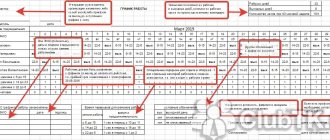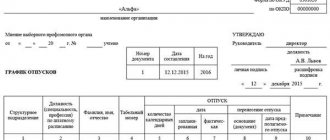Labor Code of the Russian Federation, payment for processing is made in the following order:
- the first 2 hours of activity - at one and a half times the rate;
- the rest of the time - in double.
Moreover, these coefficients are minimally determined by law. The final amounts of payment for processing are established by the internal documentation of the enterprise, i.e. they can be higher. IMPORTANT!
When accounting for total hours worked, the additional payment for overtime is calculated as of the end of the reporting period. That is, if the reporting period in a company is a quarter and, based on its results, the worker has hours of overtime work: for the 1st month of the quarter - 2 hours, for the 2nd month - 1 hour and for the 3rd month - 1 hour, then all the time processing is summed up according to the rules of Art. 152 of the 4 hours of unscheduled work received in this way, 2 hours are paid at one and a half times the rate, the rest - at double.
Rules for paying overtime hours during a shift work schedule
Paying for overtime during a shift work schedule has its own nuances, primarily related to the specifics of accurately calculating time worked in excess of the norm. You will learn how overtime is paid for on a shift schedule in our article. Where does overtime come from during a shift work schedule? Summarized recording of working hours - main points How is work paid on a shift schedule? Calculation of overtime when working in shifts How is overtime paid for during a shift work schedule?
Compensation in the form of additional rest Legislative restrictions on overtime Where does overtime come from during a shift work schedule? Download the work schedule form According to clause 4 of Art. 91 of the Labor Code, each enterprise is obliged to record the time worked by members of the workforce.
https://youtu.be/oeLsfnHx2yA
How to calculate overtime hours when recording working hours summed up
Summarized recording of working hours is used if, due to the specifics of production in the company, it is not possible to maintain the standard duration of the working week.
Hours of work are calculated not for a week, but for a period established by the administration of the enterprise: a month, a quarter or a year. Similar accounting is introduced for control: the total duration of working hours in a specified period, for example a quarter, should not exceed the legal norm. Those. You can work overtime one week, and underwork the second, etc. The results are summarized at the end of the accounting period. Then the hours of overtime work are calculated in the aggregate accounting of working hours. A distinctive feature of this type of labor accounting is that overtime in hours is summed up for the entire period, and the first 2 hours are paid at one and a half times and the rest at double.
Overtime during shift work schedule
Time worked overtime during shift work is paid in a special manner. How shift work is regulated and in what order overtime is paid during a shift schedule, we will explain in this article.
| Dear visitors! The site offers standard solutions to problems, but each case is individual and has its own nuances. |
| If you want to find out how to solve your particular problem, call toll-free ext. 504 (consultation free) |
Labor standards for shift work
The Ministry of Health and Social Development of Russia, by its Order No. 588n dated August 13, 2009, approved the Procedure that must be followed to calculate the standard work time for certain calendar periods (year, quarter, month).
The employer’s task is to organize the development of the norm by its employees so that this norm is worked out within the established accounting period. It is clear that on some days the number of hours of work will be greater, on others less. Opening hours may vary throughout the week. But balance is achieved by compensating for work on other days so that in the end the employee works his quota for the entire period. The only exceptions are certain categories of workers whose working hours are established by law.
Shift work hours and schedule
If the production process at the enterprise is arranged in such a way that:
- its duration inevitably exceeds the permissible number of working hours per day,
- it is required to use work equipment more efficiently,
- it is necessary to increase production volumes,
the employer can establish shift work for employees (Article 103 of the Labor Code of the Russian Federation). Shift work organization, as a rule, is applicable where work is carried out around the clock and cannot be stopped for some time (medical institutions, production with a continuous long cycle, conveyors, security of objects, etc.).
The conditions of shift work are determined by the shift schedule - a document that is part of the collective agreement and contains, among other things, the following essential points:
- duration of work shift,
- start and end times of shifts,
- number of shifts in a period and the order of their alternation,
- employee rest time – breaks and days off.
When drawing up a schedule, you must proceed from the current standard working hours for each category of employees for the accounting period established in the organization. At the same time, continuous work of one employee for two shifts in a row is unacceptable.
How to pay for overtime on a shift schedule
Recycling is work that is done after the end of the working day. The weekly standard of working time for any schedule in general is no more than 40 hours (Article 91 of the Labor Code of the Russian Federation), therefore hours worked in excess of this standard are considered overtime and for shift work. The Labor Code allows employers to involve their employees in excess work, but for no more than 4 hours for 2 days in a row, and each employee can overwork no more than 120 hours per year (Art.
99 Labor Code of the Russian Federation).
To account for overtime during a shift work schedule, summarized working time accounting is used. The peculiarity of such accounting is that the employer determines the accounting period himself - it can be, for example, a month, a quarter or even a year. For dangerous and harmful working conditions, the maximum accounting period does not exceed 3 months.
When calculating the time an employee worked in an accounting period, the normal length of the working week (40 hours) is taken as a basis, a multiple of the number of weeks in the period.
It is often not possible to avoid exceeding this norm during shift work. Therefore, if at the end of the accounting period it turns out that the employee has excess hours, this time is considered to be worked overtime. For those who work part-time, overtime is calculated based on the standards established for them.
Payment for overtime hours during a shift schedule is made at an increased rate (Article 152 of the Labor Code of the Russian Federation):
- for the first 2 overtime hours - at one and a half times the rate,
- for the next hours of processing - double the amount.
These are the minimum standards established by labor legislation; An internal document of the enterprise or an employment contract may establish a larger amount of payment for overtime work.
Overtime during a shift schedule can be compensated, solely at the request of the employee, not with increased pay, but with additional rest. In this case, extra hours of work are paid at the usual rate, and rest time is not subject to payment. The time provided to the employee in exchange for increased pay should not be less than the amount of time he worked overtime (Art.
152 of the Labor Code of the Russian Federation).
An example of how payment for overtime is calculated on a shift schedule, when the accounting period is a month:
The standard working time in August 2020 with a 40-hour work week is 184 hours. The employee worked 190 hours in shifts, of which 6 hours were overtime. The employee's tariff rate is 300 rubles. at one o'clock.
Let's calculate wages according to the standard : 184 hours X 300 rubles. = 55,200 rub.
Payment for the first 2 hours of processing: 2 hours X 300 rubles. X 1.5 = 900 rub.
For subsequent hours: (6 hours – 2 hours) X 300 rub.
X 2 = 2400 rub.
p>The amount of the employee’s accrued salary in August: RUB 55,200. + 900 rub. + 2400 rub. = 58,500 rub.
Article 154 Remuneration for night work
a local regulatory act adopted taking into account the opinion of the representative body of employees, an employment contract. Commentary on Article 154 of the Labor Code of the Russian Federation: The time from 10 p.m. to 6 a.m. is considered night time (Art.
96 TK). Increased pay for work during this period is ensured by applying additional payments for night work. The amounts of additional payments for night work cannot be lower than the amounts established by labor legislation and other regulatory legal acts containing labor law norms. According to the rules established by the Labor Code, you are paid only every hour with a few shifts.
Payment for overtime during a shift work schedule
IMPORTANT! When accounting for total hours worked, the additional payment for overtime is calculated as of the end of the reporting period. That is, if the reporting period in a company is a quarter and, based on its results, the worker has hours of overtime work: for the 1st month of the quarter - 2 hours, for the 2nd month - 1 hour and for the 3rd month - 1 hour, then all the time processing is summed up according to the rules of Art.
152 of the 4 hours of unscheduled work received in this way, 2 hours are paid at one and a half times the rate, the rest - at double.
- By dividing the salary portion by the standard number of hours for 12 months. That is, with a salary of 30,000 rubles. monthly and the working time standard in 2020 at 1974 hours (with a 40-hour week), the hourly rate will be 30,000 / (1974/12) = 182.37 rubles.
- By dividing the salary by the standard hours in the desired month. At a rate of 168 hours in October 2020, the hourly rate will be 30,000 / 168 = 178.57 rubles.
- When an enterprise uses summarized accounting of the period worked, the hourly rate can be calculated by dividing the salary by the average standard working hours in the reporting time. The norm in the 3rd quarter of 2020 is 528 working hours - accordingly, the tariff rate will be equal to 30,000 / (528/3) = 170.45 rubles.
Experienced personnel officers who use summarized accounting of hours worked when drawing up a shift schedule, as a rule, first schedule all shift changes for the desired year, and only after that, after calculating the working hours, they select the optimal accounting period. This is done in order to avoid the occurrence of overtime based on the results of the period taken as a basis, since overtime included in the schedule in advance is a violation of labor legislation. Shift work is different in that it is quite difficult to comply with the established norms for the duration of work - both during the day and during the week, therefore it is impossible to use the daily method of accounting, while the weekly method is used, but rarely.
More often in such cases, the summarized method is used, within the framework of which a shift work schedule for employees is drawn up. If the schedule is drawn up incorrectly or unforeseen circumstances intervene (illness of a shift worker, force majeure, etc.), based on the results of the planned shifts, work hours are formed that go beyond the limits established in the code. Thus, it is worth talking in more detail about the essence of summarized accounting of time worked.
Payment
In accordance with the norms of Article 152 of the Labor Code of the Russian Federation, compensation for overworking working hours is carried out in two ways:
- payment of one and a half times the initial two hours of additional labor and double the subsequent hours;
- providing additional rest time equal to overtime hours.
Also, the provisions of the specified article give the employer the right to increase the amount of compensation based on its own financial capabilities.
Algorithm and calculation formula
Due to the fact that the procedure for paying for work above the norm is stipulated in the Labor Code of the Russian Federation only in general, many do not know how to calculate overtime.
Therefore, it is more advisable to use the recommendations given in Letter of the Ministry of Health No. 16-4/2059436, according to which one should be guided by the calculation procedure specified in Article 153 of the Labor Code of the Russian Federation, namely for calculating additional hours of work on weekends.
Letter of the Ministry of Health of Russia dated July 2, 2014 N 16-4/2059436
In particular, the following formula should be used for calculation:
The established norm of labor hours is subtracted from the hours actually worked during the accounting period. Then the average payment per hour is calculated, but not the total earnings, but the established salary or tariff rate. Then the hourly earnings are multiplied by 1.5 for the first hours and by 2 for subsequent hours, and the resulting amount is multiplied by the number of hours worked in excess of the norm.
The calculation is as follows: 75 x 1.5 x 2 + 75 x 2 x 4 = 825 rubles.
With salary
In order to obtain an hourly wage at a salary, you must divide the established salary by the standard hours in the reporting period, and then multiply by the number of hours worked in excess of the standard according to the formula described above.
Let’s say the standard hours in September are 176 hours, and the employee’s salary is set at 15,000 thousand rubles.
15000: 176 = 85 rubles.
The processing time was 6 hours.
85 x 1.5 x 2 + 85 x 2 x 4 = 935 rubles.
At tariff rate
Considering that with the tariff rate the employee is initially set the amount of payment in hours, there is no need to calculate them; it is enough to multiply the tariff by one and a half or double the amount, and then by the number of hours worked in excess of the norm as follows:
100 x 1.5 x 2 + 100 x 2 x 4 = 1100 rubles.
What is working time tracking? Find out from our article. What is part-time work? Read here.
How to recognize a fake sick leave? See here.
Overworking of working time - what is overtime working time, payment, with a shift schedule
A shift schedule is a schedule that is drawn up if the working day of certain employees, due to production requirements, must be longer than the standard working day or must take place outside of the 9-18 hours. In this case, too, overtime may be required - even beyond the longer time that the employee will need to work in accordance with the shift schedule. These minor hours issues are quickly resolved and usually have nothing to do with employees working overtime. There are also situations when one employee of an enterprise holds several positions at once.
In this case, payment is regulated by a signed agreement, and although the citizen is at the workplace for a longer period, this is not considered overtime. Naturally, despite clear standards of labor hours, in many companies unforeseen circumstances arise that require the involvement of workers in excess of the agreed number of hours of employment, which is why the law provided for the possibility of attracting a more approved standard, subject to certain restrictions and the provision of compensation. In particular, with a normal work schedule , which provides for a 40-hour weekly employment and a monthly accounting period, calculating the hours worked above the norm is quite simple, given that a worker must work only 8 hours every day, which on average can be only 160 hours per month.
Accordingly, hours worked in excess of the specified norm will already be overtime.
- if an emergency or disaster occurs at the enterprise, then workers may be left to eliminate the consequences of this problem;
- in the event that it is urgently necessary to eliminate an emergency in the heating system, gas supply to houses, as well as central hot and cold water supply, when eliminating problems with transport or communication systems;
- workers need to remain at the enterprise because work needs to be done to protect the public (this could be a natural disaster or martial law).
In enterprises that, due to the specifics of production, cannot provide forty hours of work per week, which is important for institutions with a continuous process, in accordance with the norms of the law, it was allowed to use summarized time accounting , which, in accordance with Art. 104 of the Labor Code of the Russian Federation is shift work according to a schedule with shifts from 8 to 24 hours with floating days off and with the condition of meeting the standard hours for the reporting period, which can be equal to a quarter or half a year.
Procedure for calculating compensation
As a rule, remuneration for the standard hours worked is carried out in the amount of the salary or hourly rate established at the enterprise, to which, on the basis of local acts, other payments may be additionally provided, for example, bonuses for length of service or bonuses.
Moreover, if an employee exceeds the standard hours of employment, he is also entitled to an additional payment in the amount proportional to the number of additional hours worked, multiplied by one and a half or double coefficient.
The calculation of payment for overtime directly depends on several factors :
- working hours, which can be normal, that is, five days or shifts with floating days off;
- payroll system, which may provide for a salary or hourly rate.
In particular, with a normal work schedule , which provides for a 40-hour weekly employment and a monthly accounting period, calculating the hours worked above the norm is quite simple, given that a worker must work only 8 hours every day, which on average can be only 160 hours per month. Accordingly, hours worked in excess of the specified norm will already be overtime.
It will also be easy to calculate the amount of additional payment in accordance with Article 152 of the Labor Code of the Russian Federation, taking into account that with a normal schedule, as a rule, a salary system is used. That is, to begin with, in accordance with the norms of Letter of the Ministry of Labor No. 1202-21, you just need to calculate the cost of one hour, and then multiply it by the hours of employment with the established coefficient.
For example, an accountant’s salary is 20,000 rubles, there were 20 working days in a month and workdays lasted 8 hours.
20000 / 20 / 8 = 125 rubles per hour.
At the same time, 4 hours were worked above the norm. Three hours at the beginning of the month and 1 hour in the middle.
The first hours of employment in accordance with Article 152 of the Labor Code of the Russian Federation are paid using a coefficient of 1.5, subsequent hours with a double one.
125 * 1.5 * 2 + 125 * 2 * 1 = 456+250 = 706 rubles.
125 * 1.5 * 1 = 187.5 rubles.
Thus, the overpayment for processing will be: 706 + 187.5 = 893.5 rubles.
But with a shift work schedule, calculating overtime pay can cause difficulties due to the fact that in companies with a similar schedule, total time recording is established with a reporting period of a quarter or even half a year and two methods of calculation.
That is, if, during a five-day workday, overtime overtime based on documents is visible already at the end of the month, then with summarized accounting, hours worked in excess of the norm will be visible only at the end of the quarter. For example, with a regular five-day work week, the monthly work norm is on average 160 hours; with quarterly accounting, the norm will be 480 hours (160 * 3).
With a normal schedule, the employee will fulfill the work quota in any case, given that he will work for four weeks for 40 hours, but with a shift schedule, the number of hours of employment may vary. That is, in the first month the norm may be exceeded, and in the second month vice versa, but in general for the quarter the employee will still work the norm established by law.
For example, the standard hours for the quarter are 480 hours, while the employee was busy for 500 hours, which amounted to 20 hours of overtime. At the same time, the worker’s salary is 20,000, which is 60 thousand per quarter.
60000 / 480 = 125 rubles per hour.
And then the calculation of overtime can be done in two ways.
For actual hours worked during each shift. That is, the employee could overwork 2 hours for 10 shifts, which means payment for additional employment will be made at one and a half times the rate (Article 152 of the Labor Code of the Russian Federation):
125 * 1.5 * 20 = 3750 rubles.
According to the results of the accounting period , which implies payment at one and a half times only for two hours out of 20 in excess of the norm, while the remaining 18 hours will be paid at double:
125 * 1.5 * 2 + 125 * 2 * 18 = 375 + 4500 = 4875 rubles.
Payment by the second method involves paying overtime in a larger amount, which is not beneficial for companies, so many prefer to calculate overtime using the first method, given that at the legislative level the procedure for calculating the agreed situation is not fully regulated.
Thus, the Letter of the Ministry of Health No. 16-4/2059436 states that when calculating overtime pay, it is recommended to apply the norms of Article 153 of the Labor Code of the Russian Federation, which establishes that to calculate double payments, one should take into account the salary or rate, and not the average earnings, while There is no way to account for overtime hours. That is, the employer can make payment in accordance with the time worked for each shift separately, or sum up the time worked for the quarter and pay with a coefficient of 1.5 only for the first two hours.
How to pay for overtime hours during a shift work schedule: calculation
Recycling is work that is done after the end of the working day. The weekly standard of working time for any schedule in general is no more than 40 hours (Article 91 of the Labor Code of the Russian Federation), therefore hours worked in excess of this standard are considered overtime and for shift work.
The Labor Code allows employers to involve their employees in excess work, but for no more than 4 hours for 2 days in a row, and each employee can overwork no more than 120 hours per year (Article 99 of the Labor Code of the Russian Federation). At the same time, for employees who are employed in hazardous or harmful types of production, the longest period of summarized accounting is a quarter . In other words, they can work out the norm for a week or for a month, but during each individual quarter they can work no more than the established norm of time. However, at the same time, for employees of such industries there is a reservation, according to which the accounting period for them can still be increased for a year .
For example, such a situation may arise if an employee is unable to work less than the required 8 or 40 hours per day or week, respectively. In this case, the maximum permissible number of hours for the entire year is calculated, and the shift schedule is drawn up in accordance with the result obtained. As a result, it may turn out that an employee works 50 hours one week, 30 hours another, and at the end of the year the established norm is met. Shift work is different in that it is quite difficult to comply with the established norms for the duration of work - both during the day and during the week, therefore it is impossible to use the daily method of accounting, while the weekly method is used, but rarely. More often in such cases, the summarized method is used, within the framework of which a shift work schedule for employees is drawn up.
If the schedule is drawn up incorrectly or unforeseen circumstances intervene (illness of a shift worker, force majeure, etc.), based on the results of the planned shifts, work hours are formed that go beyond the limits established in the code. Thus, it is worth talking in more detail about the essence of summarized accounting of time worked.
How are overtime hours calculated?
HR and accounting department employees are required to correctly take into account the duration of work for each employee. According to Art. 91 of the Labor Code of the Russian Federation, the normal length of working time is 40 hours per week. It is important to remember that an employee should not work beyond the norm for more than 4 hours, 2 days in a row and longer than 120 hours a year (Part 6 of Article 99 of the Labor Code of the Russian Federation). For some categories of citizens, a shortened day (24-35 or 36 hours a week) is the norm, and working beyond this time is overtime for them.
The time worked must be reflected in the working time sheet, form T-12 or T-13. Overtime hours o or code 04. There is a timesheet program for calculating overtime hours, which automates filling out the timesheet and calculates payment for overtime using formulas.
Overtime work is paid at an increased rate (Article 152 of the Labor Code of the Russian Federation):
- for the first 2 hours at one and a half times;
- for the following hours - double.
Instead of increased pay, the employee can choose another option - get additional time for rest (no less than he worked overtime). In this case, processing is still paid, but at a single rate.
What is the minimum amount an employer must pay for working after hours?
Article 152 of the Labor Code of the Russian Federation does not contain an answer to this question, and officials of the Ministry of Health in a letter dated 07/02/14 N 16-4/2059436 explain the situation as follows: to pay overtime you can use the rule of Art. 153 Labor Code of the Russian Federation. According to the norm of this article, the minimum amount of double payment is a double tariff without taking into account compensation and incentive payments. According to the logic of this norm, the least that an employer must pay is the employee’s average hourly earnings without bonuses and allowances, multiplied by 1.5 or 2 and multiplied by the number of hours worked in excess of the norm. Local regulations of a particular company, labor and collective agreement may establish higher payment for overtime: allowances and additional payments are included in the calculation in whole or in part, if the employer is ready for this.
Formula for calculating overtime:
Amount of surcharge for overtime with cumulative accounting and shift schedule
The situation is that in the accounting department entrusted to me, accounting was done manually. There are no contacts with previous employees of the accounting department. There is little time, but a lot of work, so 1C was purchased and integration began. When entering salary data into 1C ZUP 3.1, we noticed that the calculation of overtime is considered as an additional payment (0, 5 and 1), which led to questions arising.
There are no settings to calculate differently in 1C, except to edit the regulated formulas, so we contacted technical support. 1C technical support, who carried out the integration, claims that everything is considered correct, since the hours are already paid for in the salary. But, searching for information on the Internet gives 2 opinions (pay above the salary and pay extra), and no one provides links to the law, norm, explanation, letter.
And the situation is serious, because wages and people cannot be offended on the one hand, and the enterprise on the other.
- Accrued based on salary: 14,000/180 * 180 = 14,000 rubles.
- Additional payment for holidays: 14,000/136 * 100% = 102.941 * 36 hours = 3,705.88 rubles.
- Additional payment for night work: 14,000/136 * 50% = 51.47 * 64 = 3,294.08 rubles.
- Additional payment for overtime: The standard working time according to the production calendar is 136 hours, the employee actually worked 180 hours (according to the shift schedule), 36 hours fell on holidays and weekends (180-136-36=8 hours), i.e. overtime was 8 hours . Payment for the first 2 hours 14,000/136*50% = 51.47*2 = 102.94 rubles. Payment for the next 6 hours 14,000/136 * 100% = 102.94 * 6 = 617.64 rubles. In total, the additional payment for processing amounted to 720.58 rubles.
- Total accrued: salary 14,000 + holidays 3,705.88 + night 3,294.08 + overtime 720.58 = 21,720.54 rubles.
mihbel good morning! First, a little criticism on my part. Calculation of the hourly rate based on the salary should be carried out according to a unified methodology. Either you apply the standard according to the production calendar everywhere, or you apply the standard according to the schedule everywhere. It turns out that your salary is calculated at one rate, and night and weekend work along with overtime is calculated at another rate. In your case, the calculation in 1s would be correct if you paid like this: 14000/136 *180 = 18529, 41 rubles. — payment based on salary (specify the monthly rate in local regulations for this scheme); Additional payment for holidays: 14,000/136 * 100% = 102.941 * 36 hours = 3,705.88 rubles. - here it is correct Additional payment for work at night: 14,000/136 * 50% = 51.47 * 64 = 3,294.08 rubles. - this is correct. Then you calculate as in the program and get the correct result. This is where the surcharge comes in. Hello. The organization (LLC, OSN) employs watchmen on a shift work schedule (shift duration 12 hours, 2/2).
The organization keeps summarized records of working hours, the accounting period is a month. The salary is set at 14,000 rubles. In January, the employee worked 180 hours (15 shifts), which corresponds to his shift schedule.
The employee was not required to work overtime by orders, but worked according to the schedule. At the same time, 3 shifts (36 hours) occurred on holidays and non-working days from January 1 to January 7. Night work was 64 hours (50% additional payment).
Country of Soviets
With this mode, the evening shift will be from 14 to 22 hours. What additional payment is due for working on the evening shift? The amounts of such additional payments cannot be lower than those established by law. Thus, the additional payment for work on the evening shift is established in subparagraph “a of paragraph 9 of the resolution of the Central Committee of the CPSU, the Council of Ministers of the USSR and the All-Union Central Council of Trade Unions of February 12, 1987 No. 194 in the amount of 20 percent of the hourly tariff rate (official salary) for each hour of work. Remuneration for work at night On the procedure for calculating hourly wage rates for employees whose work is paid at daily and monthly rates (salaries), to determine additional remuneration for work at night, see.
Explanation of the State Labor Committee of the USSR, the Secretariat of the All-Union Central Council of Trade Unions dated December 27, 1972 N 12/35. Each hour of work at night is paid at an increased rate compared to work under normal conditions, but not lower than the amounts established by labor legislation and other regulatory legal acts containing labor law norms. (as amended. An important nuance in these calculations is whether to take bonuses into account. The Ministry of Health in letter No. 16-4/2059436 dated 04/02/2014 considers it more appropriate to use the average monthly amount of time and take into account the salary without additional and bonus payments.
It is the employer’s right to choose another option; he can include bonuses in the calculation, stipulating this in local regulations. You have a monthly salary, therefore, if you perform work within the normal number of working hours during the accounting period, you must be paid this salary. According to Art.
104 of the Labor Code of the Russian Federation, summarized recording of working time can be introduced in those organizations or when performing certain types of work where, due to the conditions of production (work), the daily or weekly working hours established for a given category of workers cannot be observed. The only requirement of the law in this case is compliance with the following condition: the duration of working hours for the accounting period (month, quarter and others, but not more than one calendar year) should not exceed the normal number of working hours. Unfortunately, the law does not clarify what can be considered a normal number of working hours.
Additional payment for evening hours labor code
The amounts of payments established by a collective agreement, agreements, local regulations, employment contract cannot be lower than those established by labor legislation and other regulations containing labor law norms. At the same time, the Labor Code of the Russian Federation does not mention such a thing as the evening shift, and does not establish the employer’s obligation to pay at an increased rate for work on the evening shift. Previously, an additional payment for the evening shift in the amount of 20% was provided for in paragraph.
Processing on a shift schedule
Shift work is different in that it is quite difficult to comply with the established norms for the duration of work - both during the day and during the week, therefore it is impossible to use the daily method of accounting, while the weekly method is used, but rarely. More often in such cases, the summarized method is used, within the framework of which a shift work schedule for employees is drawn up. If the schedule is drawn up incorrectly or unforeseen circumstances intervene (illness of a shift worker, force majeure, etc.), based on the results of the planned shifts, work hours are formed that go beyond the limits established in the code.
Thus, it is worth talking in more detail about the essence of summarized accounting of time worked. Experienced personnel officers who use summarized accounting of hours worked when drawing up a shift schedule, as a rule, first schedule all shift changes for the desired year, and only after that, after calculating the working hours, they select the optimal accounting period. This is done in order to avoid the occurrence of overtime based on the results of the period taken as a basis, since overtime included in the schedule in advance is a violation of labor legislation. The Labor Code of the Russian Federation obliges every organization and every enterprise to record the time actually worked by employees.
At the same time, the code establishes maximum working hours, which normally amount to 40 hours per week (eight working hours daily, five days a week). For a number of categories defined by law, the standard working time is determined to be 24, 35 or 36 hours. If the schedule is drawn up incorrectly or unforeseen events occur (force majeure, illness of employees), as a result of the planned shifts, working hours appear that go beyond the norms established by law. Such excess hours require special registration and additional monetary compensation to the employee.
The calculation of the amount of additional payments depends on the remuneration system in force in the organization and on the method of recording time worked. How to calculate overtime during a shift schedule
Key points related to summary accounting
Article 104 of the Labor Code fully describes the summarized version of accounting. Thanks to this scheme, it is easier to develop schedules and take into account the actual time worked. Even if the shifts vary in length by day and week.
This also applies to situations where indicators go beyond the current norms and standards. The main thing is that the established standard for performing duties for the month is observed. Internal documentation of the enterprise usually reflects information regarding which method is used.
When drawing up a schedule for shifts, according to summarized time tracking, it is recommended to follow some tips. For example, first all shift changes for the year are scheduled. The next step is to select the reporting period that is most suitable for a particular situation.
This makes it easier to develop a schedule by period without exceeding the norms. Processing cannot be included in the schedule in advance; this is a direct violation of current legislation.
But when calculating during implementation, excess working time is often discovered. Some subordinates work more than the specified norms. Because of this, it is necessary to issue additional compensation and monitor the documentation. The systems used at the enterprise determine the features of accounting, payment and the method according to which time worked is recorded.
For information on summarized working time recording, see here:
https://youtu.be/Go5eBPMsKr0











